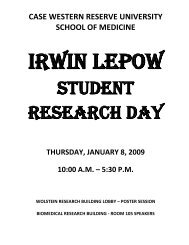4-28-2011 - Case Western Reserve University School of Medicine
4-28-2011 - Case Western Reserve University School of Medicine
4-28-2011 - Case Western Reserve University School of Medicine
Create successful ePaper yourself
Turn your PDF publications into a flip-book with our unique Google optimized e-Paper software.
34.<br />
- 3 -<br />
Dr. Armitage inquired if there was a similar rise in MCAT scores.<br />
Dr. Dan Wolpaw mentioned that our students’ MCATs have increased from 33 to<br />
Dr. Armitage played devil’s advocate and wondered if CWRU is simply<br />
recruiting good test-takers.<br />
Dr. Papp refused to accept that test taking skills alone account for the observed<br />
increases in CWRU students’ performance and insisted that our curriculum is most<br />
certainly a contributing factor.<br />
Dr. Young regards MCATs as the best predictor <strong>of</strong> USMLE Step 1 performance.<br />
Dr. Papp explained that the standard deviation indicated on the graph is an<br />
important measure in validating that our students score significantly higher than the<br />
national average.<br />
Dr. Wolpaw added that our new curriculum has things added that cannot be<br />
measured.<br />
Dr. Papp called attention to a list <strong>of</strong> disciplines with “whisker plots” indicating<br />
the national average in each discipline area and within that range, boxes indicating<br />
CWRU performance. The vertical green line represents the national mean. All boxes<br />
are to the right <strong>of</strong> the green line. From this table, we can conservatively conclude that<br />
there are subject areas in which CWRU students, on average, are performing above<br />
the national average.<br />
Dr. Papp explained that we are working in means. The distribution <strong>of</strong> scores is<br />
lost when you summarize scores down to one number. Both national and CWRU scores<br />
on the USMLE Step 1 during 2010 were plotted on a range <strong>of</strong> less than 155 (failing) to<br />
greater than 245. The passing score was 188, a three-digit score.<br />
Dr. Armitage added that the NBME will stop providing the two-digit scores to<br />
residency program directors, because <strong>of</strong> the resulting confusion and frequent<br />
misinterpretation.<br />
Dr. Young added that the licensure exam is designed for students to pass. Scores<br />
are skewed and do not represent a Gaussian distribution. The exam is not strictly normreferenced.<br />
The NBME uses performance <strong>of</strong> test-takers from the previous three years as<br />
the criterion-reference group.<br />
Dr. Armitage questioned whether you can predict poor performance—be it<br />
medical, personal, or academic.<br />
Dr. Kent Smith felt that it is easier to predict performance at the right (strong)<br />
than at the left (failing).<br />
Dr. Young reiterated his contention that MCATs are the only significant<br />
predictor <strong>of</strong> USMLE Step 1 performance.<br />
Dr. Papp and Dr. Wilson-Delfosse disagreed. Using the NBME test item bank<br />
to construct cumulative achievement tests for students at the end <strong>of</strong> each block, we<br />
have found that the combined aggregated scores can account for an estimated 60%<br />
<strong>of</strong> the variance on USMLE Step 1.<br />
Dr. Armitage feels that our medical school does so much more than simply<br />
prepare students to pass the USMLE Step 1.<br />
Dr. Papp added that we are trying to write integrative reasoning questions that<br />
test more than only medical knowledge.
















